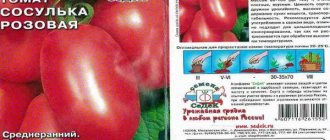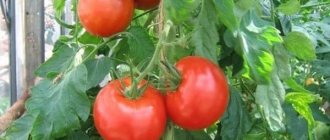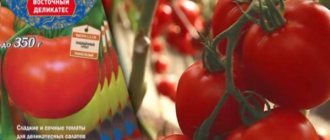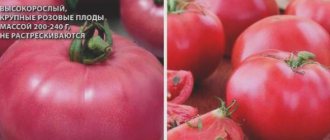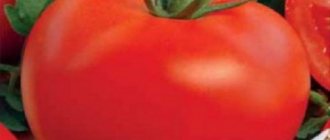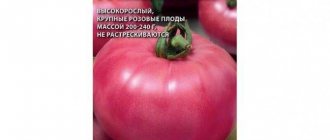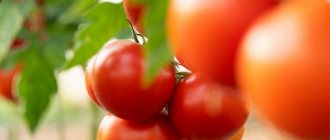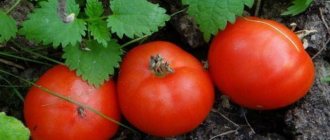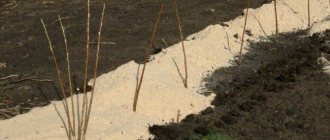Classic F1 is a highly productive hybrid from the Dutch tomato line. Tomato is cultivated in different climatic zones. In northern conditions, in Siberia, in the Central region, greenhouse facilities are required for cultivation. In Crimea, Stavropol, Krasnodar, the hybrid is cultivated in open areas.
| Height | Landing location | Ripening time | Fruit color | Fruit size | Origin | Fruit shape |
| short | Greenhouse, Open ground | Early ripening | Reds | Average | Hybrid | Plum-shaped or oval |
Tomato Classic f1: variety description
| Variety name | Classic |
| general description | Mid-season determinate hybrid |
| Originator | China |
| Ripening period | 95-105 days |
| Form | Elongated |
| Color | Red |
| Average weight of tomatoes | 60-110 grams |
| Application | Universal |
| Productivity of the variety | 3-4 kg per bush |
| Features of cultivation | Standard agricultural technology |
| Disease resistance | Resistant to most diseases |
This is a determinant, standard hybrid of tomatoes, has the same name F1.
In terms of ripening time, it belongs to the mid-early species, that is, 95-105 days pass from planting seedlings to the first ripe fruits. The plant is medium-sized, 50-100 cm. Like many hybrids, it has complex resistance to tomato diseases. This hybrid variety is recommended for growing in film shelters and in open ground.
Fruits that have reached varietal maturity are red in color, round in shape, slightly elongated. The taste is bright, characteristic of tomatoes. They weigh 60-80 grams, when first collected they can reach 90-110 grams . The number of chambers is 3-5, the dry matter content is about 5%. Ripe tomatoes can be stored for a long time and tolerate transportation well.
This species was obtained by Chinese breeders in 2003, and received state registration as a hybrid variety for unprotected soil and film shelters in 2005. Since then, it has enjoyed deserved popularity among lovers of small-fruited tomatoes and farmers.
“Classic F1” can produce the best harvest in the south in open ground . In areas of the middle zone, growing without film shelters is risky, so it is better to cover. In more northern parts it is possible to grow only in greenhouses.
You can compare the weight of the fruits of this variety with others in the table below:
| Variety name | Fruit weight |
| Classic | 60-110 grams |
| Peter the First | 30-250 grams |
| Crystal | 30-140 grams |
| Pink flamingo | 150-450 grams |
| Baron | 150-200 grams |
| Tsar Peter | 130 grams |
| Tanya | 150-170 grams |
| Alpatieva 905A | 60 grams |
| La la fa | 130-160 grams |
| Demidov | 80-120 grams |
| Dimensionless | up to 1000 grams |
Tomato Matador - what you need to know
The healthy and tasty fruits of tomatoes have made the plant popular among vegetable growers. The Matador tomato was developed thanks to the work of breeders from the large agricultural company Semco Junior. The originator recommends the hybrid for cultivation on an industrial scale.
General information about the variety
Russian breeders developed tomatoes for cultivation in open ground, film shelters and greenhouses. The location of cultivation depends on climatic conditions.
Characteristics of the plant and description of the appearance of the variety:
- early ripening, up to 115 days pass before the fruit is harvested;
- determinant;
- bush height up to 75 centimeters;
- simple inflorescence;
- medium-sized, green foliage;
- simple inflorescence;
- the stalk has an articulation;
- average fruit size;
- average yield, up to 6 kilograms per square meter of planting;
- resistance to many nightshade diseases - Alternaria and tobacco mosaic;
- transportation of fruits over long distances is permissible;
- there is a possibility of long-term storage.
When grown on an industrial scale, up to 45 tons of fruit are collected from one hectare of planting. The berry is distinguished by the following characteristics:
- cylindrical round shape;
- red color;
- smooth;
- dense;
- has 3–4 nests;
- aromatic;
- thin skin;
- no tendency to crack;
- weight does not exceed 100 grams;
- sweet taste, with sourness.
This is interesting: Tomato Marusya: our point of view on the issue
Characteristics of the Tomato variety Matador (A)
| Variety: | early ripening |
| Determinacy: | determinant |
| Soil type: | open |
| Fetal weight: | 85-100 g |
| Fruit shape: | cylindrical, smooth |
| Fruit color: | red |
| Packing: | 0.1 g |
Growing Tips
The heat-loving plant prefers the seedling method of planting. It is advisable to begin work on sowing seeds in mid-March. Healthy seedlings require compliance with a number of rules:
- mandatory maintenance of temperature conditions not lower than 22 degrees;
- use warm water for irrigation, spray irrigation before emergence;
- the first shoots should receive a sufficient amount of ultraviolet radiation, the duration of daylight should be at least 16 hours;
- preliminary hardening before planting.
IMPORTANT! The best yield is achieved when forming a tomato with 1–2 stems
The originator advises planting tomatoes in a greenhouse or open ground in mid-May. For planting, you should use a pattern of 60 by 30–40 centimeters; there should be no more than five tomatoes per square meter of land.
The small size of the bush allows you to place a large number of bushes in a limited area.
To get a good harvest, it is enough to follow the standard rules for caring for tomatoes. A determinate bush does not require staking or installation of supports. Suitable for sowing for beginning gardeners.
Description of the variety Tomato Matador (A)
An early ripening variety for open ground. The period from germination to the beginning of ripening is 105-115 days. The plant is 35-45 cm high. The fruit is cylindrical, smooth, dense. The color of the unripe fruit is green, the ripe one is red. Number of nests 3-4. Weight 85-100 g. The taste is excellent. Transportability is high. The variety is resistant to a range of diseases. Universal use.
Plant description: Early ripening hybrid. Determinant. For open ground. The period from germination to the beginning of ripening is 105-115 days. The plant is 60-75 cm high. The fruits are red, weighing 75-85 g.
Biological characteristics: Tomato is a sun-demanding crop. Heat-loving plant. Heat is one of the main factors and largely determines the growth rate, ripening and yield of tomatoes.
Soil moisture for tomatoes is somewhat less important than heat. Air humidity is of great importance for the normal development of tomatoes. It should not exceed 50-60% (in the first 10-12 weeks it should be within 60-65%).
Sandy loam and light loamy soils in mechanical composition, with a high content of humus and nutrients, are considered the best for cultivating tomato crops.
- Resistance to environmental conditions and diseases: Resistant to TMV, Alternaria.
- Agrotechnical features: Sowing March 20-30, seedling planting May 15-25, sowing pattern 60 x 30-40 cm, harvesting July 1-August 15.
- Productivity: 32.0-45.0 t/ha.
Quality characteristics: Excellent taste. Transportability is high.
Use: Universal use. For industrial production.
Characteristics
These tomatoes are well suited for whole-fruit canning and barrel pickling. They are wonderful fresh and will decorate any table. Juices, pastes and purees are very healthy and tasty. If you properly care for the hybrid variety “Classic F1”, then you can collect 3-4 kg of fruit from one bush.
The recommended planting density for it is 4-5 plants per square meter. m, thus comes out to 20 kg. For such a medium-sized hybrid, this is a very good yield result.
| Variety name | Productivity |
| Classic | up to 20 kg per square meter |
| Lazy | 15 kg per square meter |
| Honey Heart | 8.5 kg per square meter |
| Summer resident | 4 kg per bush |
| Banana red | 3 kg per bush |
| Doll | 8-9 kg per square meter |
| Nastenka | 10-12 kg per square meter |
| Broody | 10-11 kg per square meter |
| Olya la | 20-22 kg per square meter |
| Fat Jack | 5-6 kg per bush |
| Bella Rosa | 5-7 kg per square meter |
Among the main positive qualities of the hybrid variety “Classic F1” are::
- early ripeness;
- resistance to lack of moisture;
- tolerance to temperature changes;
- disease resistance;
- good yield.
Among the disadvantages, it should be said that this species is quite capricious in terms of feeding. Gardeners also note that it does not get along well with other types of tomatoes. Among the features of the “Classic F1” tomatoes, it is worth noting its resistance to external factors. It must also be noted for its productivity and very high resistance to pest diseases.
Read more about fertilizers for tomatoes in the articles on our website:
- How to properly use phosphorus, complex, mineral, ready-made fertilizers?
- How to use iodine, ash, hydrogen peroxide, ammonia and boric acid for fertilizing?
- What are fertilizers for seedlings, when picking, foliar fertilizers?
Landing
The seeds do not need to be stimulated or disinfected in advance, since the material is completely prepared by the originator.
Sowing dates: 2-3rd decade of March, beginning of April. Use a nutrient mixture of turf, loose, neutral. Bury the seeds 1 cm into the grooves.
How to care for seedlings:
- irrigate 1-2 times a week;
- keep under film until germination;
- fed with special solutions (Kemira, Krepysh);
- dive at 1-2 leaves;
- harden for 7-10 days before transplanting.
Features of cultivation
Growing a Classic f1 tomato is not particularly difficult. Although the plant is undersized, it is advisable to strengthen its trunk with tying, and its branches with supports. The bush is formed into 3-4 stems, usually three. At all stages of growth, it really needs complex feeding.
Advantages and disadvantages
When considering the description of the Classic f1 tomato, a number of positive characteristics deserve attention:
- high yield rates: about 5 kg of selected tomatoes are harvested from 1 bush, and from 1 sq. m - about 20 kg;
- rapid fruit ripening;
- resistance to temperature changes;
- high levels of the immune system: this variety is not affected by late blight or powdery mildew.
The main disadvantage of the Classic tomato is its pickiness when it comes to feeding. It also does not get along well with other tomatoes.
Diseases and pests
Tomato Classic F1 may be subject to fruit cracking. It is not difficult to fight against this disease; it will be enough to regulate the humidity of the environment. Tattu or Antrakol are successfully used against diseases such as dry spotting.
Against other types of diseases, you only need prevention, watering and lighting regimes, timely application of fertilizers, these measures will protect your tomato from all troubles.
Of the pests, the most frequently attacked is the gnawing cutworm. This happens both in greenhouse shelters and in open ground. There is a sure remedy against it: the drug “Strela”.
To prevent the pest from becoming an uninvited guest again next year, you need to thoroughly weed the soil in the fall, collect insect larvae and thoroughly spray them with “Strela.”
Slugs are also frequent guests on the leaves of this species. They can be collected manually, but it will be more effective to isolate the soil.
In the southern regions, the Colorado potato beetle can cause significant damage; Prestige is successfully used against this dangerous pest.
This is not a difficult type of tomato to care for, you just need to pay attention to applying fertilizers, even a novice gardener can cope with this, good luck to you and a rich harvest.
Productivity
With proper care, one plant produces from 3 to 4 kg of tomato fruit yield. If the recommended density is observed, the yield per 1 m2 reaches 20 kg.
Which regions are best to grow in?
The “Classic” hybrid is zoned for cultivation in the North Caucasus District, Krasnodar and Stavropol Territories. Also, “Classic F1” can be cultivated in Crimea.
The best yield is achieved when grown in the southern regions in unprotected soil. In the middle zone it is advisable to use film shelters. In more northern regions it is cultivated exclusively in greenhouses.
100 varieties of live tomatoes:
Useful video
Watch the video: five rules for growing tomatoes in a home greenhouse
| Mid-early | Super early | Mid-season |
| Ivanovich | Moscow stars | Pink Elephant |
| Timofey | Debut | Raspberry Onslaught |
| Black truffle | Leopold | Orange |
| Rosaliza | President 2 | Bull forehead |
| Sugar giant | Pickling miracle | Strawberry dessert |
| Orange giant | Pink Impression | Snow fairy tale |
| One hundred pounds | Alpha | Yellow ball |
If you find an error, please select a piece of text and press Ctrl+Enter.
Advantages and disadvantages
When considering the description of the Classic f1 tomato, a number of positive characteristics deserve attention:
- high yield rates: about 5 kg of selected tomatoes are harvested from 1 bush, and from 1 sq. m - about 20 kg;
- rapid fruit ripening;
- resistance to temperature changes;
- high levels of the immune system: this variety is not affected by late blight or powdery mildew.
The main disadvantage of the Classic tomato is its pickiness when it comes to feeding. It also does not get along well with other tomatoes.
